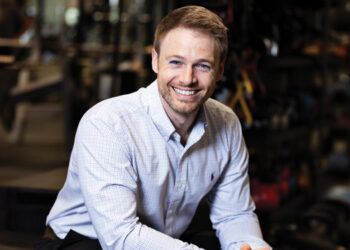A hypothesis is defined by Merriam-Webster as, “a tentative assumption made in order to draw out and test its logical or empirical consequences.”
In 2016, Chelsea Piers Fitness set out to test a hypothesis of its own: Was there a demand for large and breathtaking clubs in urban environments?
At the time, Chelsea Piers Fitness was in the business of owning and operating massive facilities. Its flagship location at Pier 60 in New York City features 150,000 square feet on the Hudson River, boasting amenities such as a six-lane, 75-foot swimming pool, basketball and sand volleyball courts, a 1/4-mile indoor track, regulation-sized boxing ring, and more.
In addition, its 400,000-square-foot Connecticut location, which opened to the public in 2012, features similar offerings as Pier 60, plus two ice rinks, 100-yard indoor turf fields, a ninja and parkour training center, squash and tennis courts, gymnastics training center, and a plethora of other amenities.
According to Sam Bernstein, the chief operating officer of Chelsea Piers Fitness, the executive team was posed with the challenge of expanding a brand that boasted such extensive and impressive facilities. “How do you expand a brand like Chelsea Piers Fitness, which is so fantastic, but also so complex in terms of its size and scale of operations?” he asked.
The solution? A smaller-scale format designed specifically for high-density, urban environments, and an initial testing ground: Brooklyn.

Testing a Hypothesis
The first challenge to testing the urban hypothesis was finding the right space. According to Keeth Smart, the regional general manager of Chelsea Piers Fitness, the plan was to open a roughly 50,000-square-foot facility, which — although significantly smaller than the brand’s other two locations — was still a large undertaking in New York City.
“In New York City we’re all space constrained, so finding the right partners where we could not only have enough square footage, but also 20-foot ceilings so you don’t have a feeling of claustrophobia, was a challenge,” explained Smart.
The solution came in the form of TF Cornerstone, a large New York real estate developer. Together, they were able to secure 52,000-square-feet of space at favorable terms, with TF Cornerstone even subsidizing membership rates for the residents sharing space with Chelsea Piers Fitness.
“TF Cornerstone wanted to put in an anchor tenant that really added value to the 700 units,” explained Bernstein. “It was a great opportunity to expand the Chelsea Piers brand, which already had incredible reach. It also served as a beta test for, if this location in downtown Brooklyn works out, can we expand to future locations and beyond?”
With a home-base for their hypothesis secured, construction began, and in June 2018 the Brooklyn location opened its doors to the public.
Ultimately, this urban location has redefined the traditional gym experience for Chelsea Piers Fitness by offering a high-end experience on a smaller scale. Highlights include a three-lane, 75-foot pool, five boutique fitness studios, communal amenities such as a coworking space and chef-led café, and luxury locker rooms.
According to Smart, the final result sought to offer a more comprehensive and better value to consumers than that currently being offered by boutique stand-alone studios, such as Flywheel or SoulCycle.
“In New York and most parts of the country, you have lots of smaller boutiques, and they might have one main studio and a locker room with a sauna — and people have grown accustomed to working out under those conditions,” explained Smart. “For us, our hypothesis was, do you want to have fitness studios be equivalent, if not better, than a boutique? So we have five dedicated fitness studios, plus the depth and breadth of space and offerings, which altogether, are able to meet the fitness needs of every single person.”
In addition, Bernstein added the kicker is that all of this is available to the consumer for a more affordable price than that being offered by most traditional boutiques.
“The boutiques have a lot of strengths, but I’d say one of the biggest barriers they face is members are paying $35 to $45 a class every time you go,” said Bernstein. “Say the average consumer goes twice a week to a boutique — all of a sudden, you’re spending twice as much as you would be spending with us, coming at an unlimited rate.”
At Chelsea Piers Fitness, you get high-end studio classes, and much more.
“Maybe you come in and workout, you go to our co-working area, you grab a smoothie — we really see ourselves almost like an urban version of a country club,” added Bernstein. “It’s really exciting for us to offer that value to the community, and I think the community has so far responded beyond our expectations.”

The Result
A little over a year later, the Chelsea Piers Fitness team feels its hypothesis has ultimately panned out. Currently, they are exceeding membership projections, and have received a positive response from the community.
“We’ve hopefully helped create a space that doesn’t feel like that cluttered traditional gym environment, while at the same time building around programming, which is of the utmost importance in today’s fitness market — all while doing so under a model we think is much more sustainable for the consumer,” said Bernstein.
In addition, Chelsea Piers Fitness has since drawn inspiration from the Brooklyn project, infusing certain elements into its other facilities. For example, it recently completed a multi-million-dollar renovation of its flagship location at Pier 60, which now boasts two outdoor sun decks, state-of-the-art fitness studios and locker rooms, and expanded turf training areas.
According to Smart, the Pier 60 renovation was also inspired by the rise in popularity of boutiques, which has ultimately driven clubs of all shapes and sizes to up their game in regards to the member experience.
“Because boutiques are laser-focused on one particular experience, it forces the larger clubs to really examine and scrutinize the entire member experience, from check in all the way to check out,” added Smart. “That was why we decided to take on such a large renovation project in the flagship location, because we knew our members and prospects were expecting to get the same experience they could at a boutique.”
In addition, Chelsea Piers Fitness has continued its focus on providing the absolute best experience in fitness for its members through an emphasis on hospitality — an emphasis that can be felt across all three of its locations.
In fact, each of the brand’s locations has a dedicated hospitality manager who is in charge of auditing the member experience, including phone calls, and coaching teammates on how to improve.
“We double down on hospitality training with our staff,” said Smart. “Operationally, because we also have one of the largest class offerings in New York City, we’re training our housekeeping and maintenance team to constantly turn over the rooms and make sure they’re perfectly clean for tours or new classes in record time so we can run classes back-to-back throughout the day. A member who took a 6 a.m. cycling class would not even know a class had been on at 5:15 a.m., for example.”
An emphasis on the member experience is also conveyed through community-focused events meant to inspire a sense of camaraderie among members and staff. Examples include free fitness classes in parks across New York City, trivia nights, wine tastings, and even art exhibits.
According to Bernstein, each of these activities ups the value of a membership at Chelsea Piers Fitness.
“The key to our success is being laser-focused on providing a great hospitality and community experience for our members, guests and neighbors,” added Bernstein. “We actively invest in hosting regular events that are either private for members and their guests, or open to the public.”
And with the Brooklyn hypothesis ultimately panning out, the Chelsea Piers team is excited to bring the brand to additional markets in urban environments and beyond.
“The goal for Chelsea Piers Fitness is to continue to find large spaces in high-density and growing neighborhoods,” said Bernstein. “We are actively looking to expand on our thesis based on the massive success from the opening of our Brooklyn location.”

Stay ahead in the fitness industry with exclusive updates!
Rachel Zabonick-Chonko is the editor-in-chief of Club Solutions Magazine. She can be reached at rachel@peakemedia.com.











